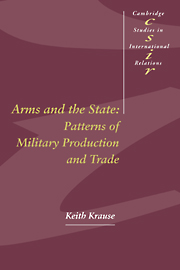Book contents
- Frontmatter
- Contents
- List of figures
- List of tables
- Acknowledgements
- Introduction
- 1 Motive forces in the evolution of the arms transfer and production system
- 2 The emergence of a global arms transfer and production system
- 3 From the Military Revolution to the Industrial Revolution
- 4 An overview of the post-1945 global arms transfer system
- 5 The dominance of first-tier producers and suppliers
- 6 Second-tier producers and suppliers: the struggle to keep pace
- 7 Dependent production and exports in the third tier
- 8 The subordinate role of arms recipients
- Conclusion
- Appendix: Arms transfer data sources and problems
- Notes
- Bibliography
- Index
8 - The subordinate role of arms recipients
Published online by Cambridge University Press: 22 September 2009
- Frontmatter
- Contents
- List of figures
- List of tables
- Acknowledgements
- Introduction
- 1 Motive forces in the evolution of the arms transfer and production system
- 2 The emergence of a global arms transfer and production system
- 3 From the Military Revolution to the Industrial Revolution
- 4 An overview of the post-1945 global arms transfer system
- 5 The dominance of first-tier producers and suppliers
- 6 Second-tier producers and suppliers: the struggle to keep pace
- 7 Dependent production and exports in the third tier
- 8 The subordinate role of arms recipients
- Conclusion
- Appendix: Arms transfer data sources and problems
- Notes
- Bibliography
- Index
Summary
A statistical overview
The global arms transfer and production system involves more than just the producers of arms: it enmeshes all major and most minor states as patrons or clients in a complex web of military relationships that includes not only weapons, but arms production technology, spare parts and supplies for weapons, and military training assistance. Chapters 2 and 3 noted how the subordinate status of recipient states in the arms transfer system was confirmed by their dependence upon external arms supplies and, occasionally, by their inability even to adopt the military and political organisation required to operate modern weapons; this chapter will examine contemporary arms recipients in the same light. Although almost all states, including the largest producers, are also arms recipients, the discussion will concentrate on those recipients who either do not produce arms or straddle the line between recipient and third-tier status.
A full discussion of the role of arms recipients in the contemporary arms transfer system would require a separate book. The issues it would raise include the relationship between arms acquisitions and the quest for security (both interstate and internal), the link between spending on weapons and economic development, and the use of arms transfer and military aid relationships as a tool of influence by arms producers.
- Type
- Chapter
- Information
- Arms and the StatePatterns of Military Production and Trade, pp. 182 - 204Publisher: Cambridge University PressPrint publication year: 1992



